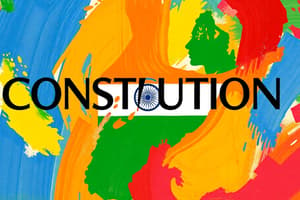Podcast
Questions and Answers
Which of the following best describes the Indian Constitution?
Which of the following best describes the Indian Constitution?
- A historical document with limited relevance today.
- A set of guidelines for the government.
- A flexible collection of traditions and customs.
- The supreme law of India, defining political principles and government structure. (correct)
The Indian Constitution was fully drafted and implemented within one year.
The Indian Constitution was fully drafted and implemented within one year.
False (B)
What date is celebrated as Constitution Day in India, marking the adoption of the Constitution by the Constituent Assembly?
What date is celebrated as Constitution Day in India, marking the adoption of the Constitution by the Constituent Assembly?
26 November
The Indian Constitution declares India to be a sovereign, socialist, __________, democratic republic.
The Indian Constitution declares India to be a sovereign, socialist, __________, democratic republic.
Match the following features of the Indian Constitution with their sources:
Match the following features of the Indian Constitution with their sources:
Which feature contributes to the unitary bias of the Indian federal system?
Which feature contributes to the unitary bias of the Indian federal system?
Directive Principles of State Policy are enforceable by the courts in India.
Directive Principles of State Policy are enforceable by the courts in India.
Which amendment introduced Fundamental Duties into the Indian Constitution?
Which amendment introduced Fundamental Duties into the Indian Constitution?
In a parliamentary form of government, the real executive power is vested in the Council of Ministers headed by the __________.
In a parliamentary form of government, the real executive power is vested in the Council of Ministers headed by the __________.
What is the minimum age requirement for a citizen to be eligible to vote in India?
What is the minimum age requirement for a citizen to be eligible to vote in India?
The Indian Constitution allows for dual citizenship.
The Indian Constitution allows for dual citizenship.
Under which article of the Constitution is the procedure for amendments laid down?
Under which article of the Constitution is the procedure for amendments laid down?
During a state emergency, also known as __________, the central government assumes greater control.
During a state emergency, also known as __________, the central government assumes greater control.
Which body ensures free and fair elections in India?
Which body ensures free and fair elections in India?
Amendments to the Indian Constitution can be initiated in either the Parliament or State Legislatures.
Amendments to the Indian Constitution can be initiated in either the Parliament or State Legislatures.
Name one Fundamental Right guaranteed by the Indian Constitution.
Name one Fundamental Right guaranteed by the Indian Constitution.
The Supreme Court of India acts as the __________ of the Constitution.
The Supreme Court of India acts as the __________ of the Constitution.
What was the key change that the 97th Constitutional Amendment Act of 2011 brought about?
What was the key change that the 97th Constitutional Amendment Act of 2011 brought about?
According to the Indian Constitution, the state can promote any particular religion.
According to the Indian Constitution, the state can promote any particular religion.
Match the types of emergencies with their effect on the governance structure:
Match the types of emergencies with their effect on the governance structure:
Flashcards
Indian Constitution
Indian Constitution
The supreme law of India, defining political principles, government structure, and citizen's rights and duties.
Constitutional declaration of India
Constitutional declaration of India
Declares India a sovereign, socialist, secular, democratic republic, assuring justice, equality, and liberty.
Written Constitution
Written Constitution
A constitution where the principles and laws are written down in a document.
Lengthy Constitution
Lengthy Constitution
Signup and view all the flashcards
Drawn from Various Sources
Drawn from Various Sources
Signup and view all the flashcards
Parliamentary Form of Government
Parliamentary Form of Government
Signup and view all the flashcards
Federal System with Unitary Bias
Federal System with Unitary Bias
Signup and view all the flashcards
Fundamental Rights
Fundamental Rights
Signup and view all the flashcards
Directive Principles of State Policy
Directive Principles of State Policy
Signup and view all the flashcards
Fundamental Duties
Fundamental Duties
Signup and view all the flashcards
Secular State
Secular State
Signup and view all the flashcards
Independent Judiciary
Independent Judiciary
Signup and view all the flashcards
Universal Adult Franchise
Universal Adult Franchise
Signup and view all the flashcards
Single Citizenship
Single Citizenship
Signup and view all the flashcards
Emergency Provisions
Emergency Provisions
Signup and view all the flashcards
Amendment Procedure
Amendment Procedure
Signup and view all the flashcards
Independent Election Commission
Independent Election Commission
Signup and view all the flashcards
Cooperative Societies Amendment
Cooperative Societies Amendment
Signup and view all the flashcards
Study Notes
- The Indian Constitution is the supreme law of India.
- It lays down the framework defining fundamental political principles, establishes the structure, procedures, powers, and duties of government institutions and sets out fundamental rights, directive principles, and the duties of citizens.
- It is the longest written constitution of any sovereign country in the world.
- It was adopted by the Constituent Assembly on 26 November 1949 and became effective on 26 January 1950.
- The constitution declares India a sovereign, socialist, secular, democratic republic, assuring its citizens justice, equality, and liberty, and endeavors to promote fraternity among them.
Key Features of the Indian Constitution
- Written and Lengthy Constitution:
- The Indian Constitution is a written document, unlike the unwritten constitution of the UK.
- It is the lengthiest written constitution in the world, originally containing 395 articles in 22 parts and 8 schedules. It now has more articles and schedules due to amendments.
- The length is attributed to the vast size and diversity of the country, historical experiences, and the detailed enumeration of fundamental rights and centre-state relations.
- Drawn from Various Sources:
- The Indian Constitution has borrowed provisions from various other constitutions worldwide.
- The Government of India Act of 1935 has a heavy influence, particularly on the administrative details.
- Fundamental Rights are inspired by the US Constitution.
- Directive Principles are taken from the Irish Constitution.
- The concept of the Rule of Law is from the British Constitution.
- Parliamentary Form of Government:
- The Indian Constitution establishes a parliamentary form of government, both at the Union and the State levels.
- The President is the nominal head of the state, while the real executive power is vested in the Council of Ministers headed by the Prime Minister.
- The legislature (Parliament) consists of the President and the two Houses (Lok Sabha and Rajya Sabha).
- Federal System with a Unitary Bias:
- India is a federation because it has a dual polity with a division of powers between the Union and the States.
- However, it has a strong unitary bias, especially during emergencies.
- The Centre has more powers than the States.
- Features like a single constitution, single citizenship, and integrated judiciary reinforce the unitary character.
- Fundamental Rights:
- The Constitution guarantees fundamental rights to all citizens.
- These rights are justiciable, meaning they can be enforced by courts.
- They include the Right to Equality, Right to Freedom, Right against Exploitation, Right to Freedom of Religion, Cultural and Educational Rights, and Right to Constitutional Remedies.
- Directive Principles of State Policy:
- These are guidelines to the state to ensure social and economic justice.
- They are non-justiciable, meaning they cannot be enforced by the courts.
- They aim at establishing a welfare state.
- Fundamental Duties:
- Added by the 42nd Amendment in 1976.
- These are duties of the citizens towards the nation.
- They include respecting the Constitution, national flag, and national anthem, protecting the sovereignty and integrity of India, promoting harmony, and safeguarding public property.
- Secular State:
- India is a secular state.
- The state does not promote any particular religion.
- All religions are treated equally.
- Citizens have the freedom of religion.
- Independent Judiciary:
- The Constitution provides for an independent judiciary.
- The Supreme Court is the highest court and the guardian of the Constitution.
- The judiciary can review legislative and executive actions.
- Universal Adult Franchise:
- Every citizen who is 18 years or older has the right to vote.
- This ensures participation of all eligible citizens in the political process.
- Single Citizenship:
- Indian Constitution provides for single citizenship.
- All citizens are citizens of India, irrespective of their place of residence.
- Emergency Provisions:
- The Constitution contains emergency provisions to deal with extraordinary situations.
- There are three types of emergencies: national emergency, state emergency (President's Rule), and financial emergency.
- During an emergency, the central government becomes all powerful and the federation turns into a unitary one.
- Amendment Procedure:
- The Constitution can be amended.
- The procedure for amendment is laid down in Article 368.
- Amendments can be initiated only in the Parliament.
- Some amendments require special majority and ratification by state legislatures.
- Integrated and Independent Election Commission:
- The Constitution provides for an Election Commission to ensure free and fair elections.
- The Election Commission is independent of the executive.
- Cooperative Societies
- The 97th Constitutional Amendment Act of 2011 gave constitutional status and protection to cooperative societies.
- In this respect it made the following three changes in the constitution:
- It made the right to form cooperative societies a fundamental right (Article 19).
- It included a new Directive Principle of State Policy on promotion of cooperative societies (Article 43-B).
- It added a new Part IX-B in the Constitution entitled as “The Cooperative Societies” (Articles 243ZH to 243ZT).
Studying That Suits You
Use AI to generate personalized quizzes and flashcards to suit your learning preferences.




